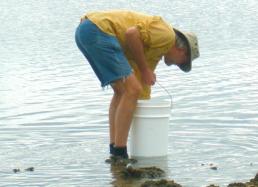2: Arrival
After meeting up with colleagues along the way, the whole team has made it to the ferry station and ultimately to North Stradbroke Island. We're at last at the Moreton Bay Research Station, run by the University of Queensland. The lab is well-equipped—together with all the gear and chemicals that we brought and had shipped, we're well set to begin our work. The weather is still cool and cloudy after rain yesterday, but patches of blue sky promise better tomorrow.
We're all assembled by mid afternoon and head out as a group to the sand flats in front of the lab—it's low tide and we're all anxious to have a first look at the local fauna. We limit ourselves to picking up mostly empty shells, taking photographs, and making detailed plans for future sampling. We'll wait on collecting live specimens until we are fully set up in the lab tomorrow.
A few experimental shovelfuls of mud yield promising results for more serious efforts later. Everywhere we look are mussels, pearl oysters, and a peculiar clam called a “Strawberry Cockle” that is on our target species list. We're covered in saltwater and mud—the kind of things that make marine biologists happy.
More soon....
—Rüdiger


